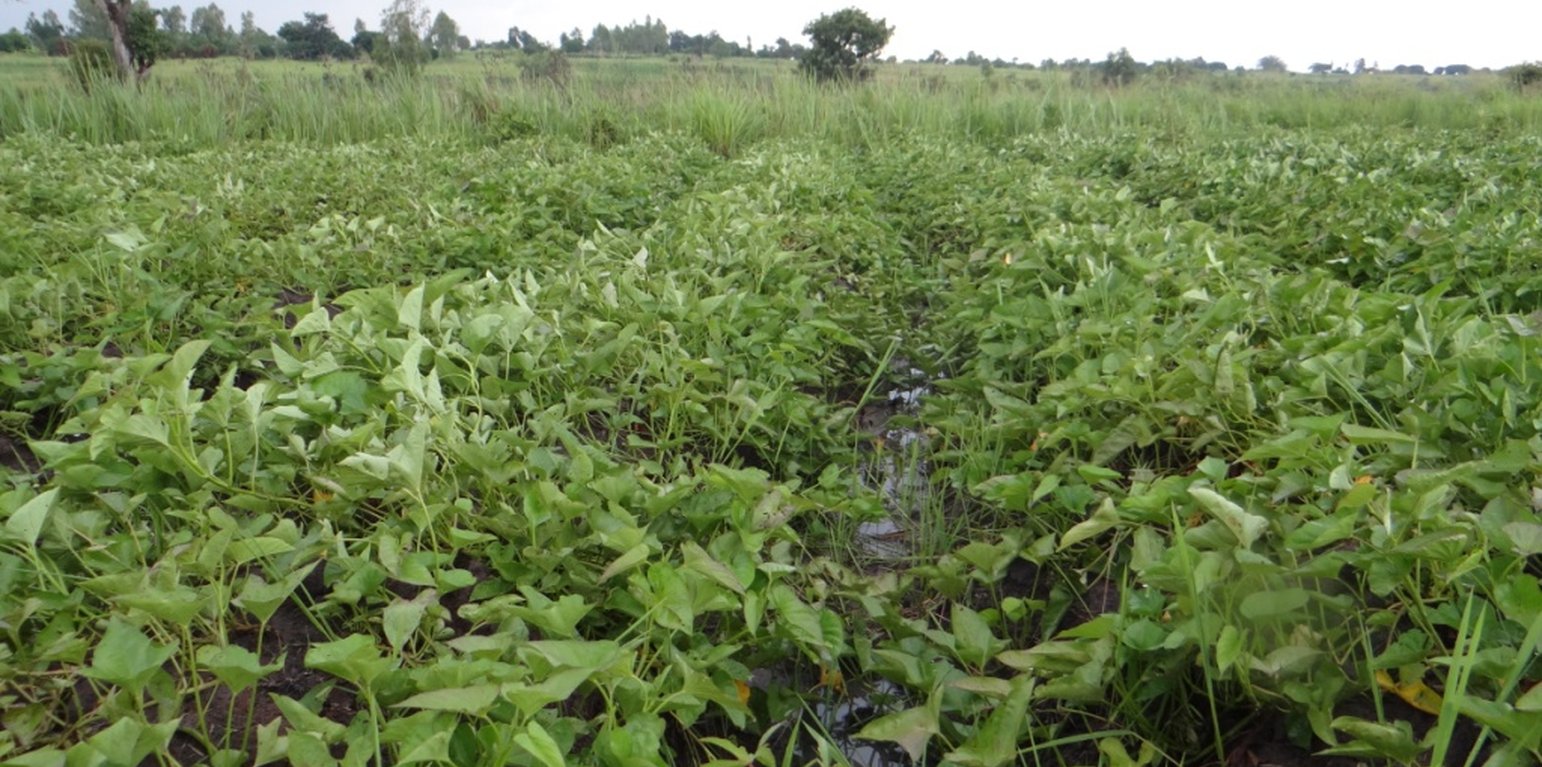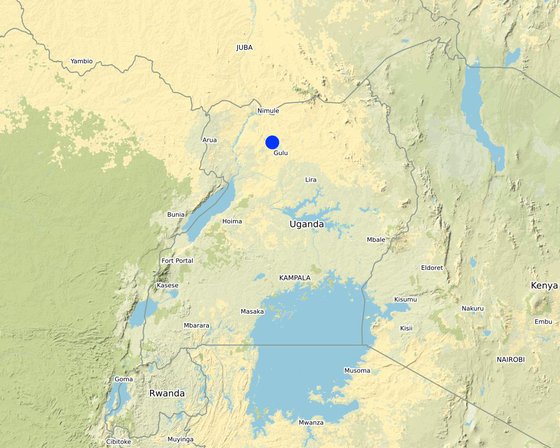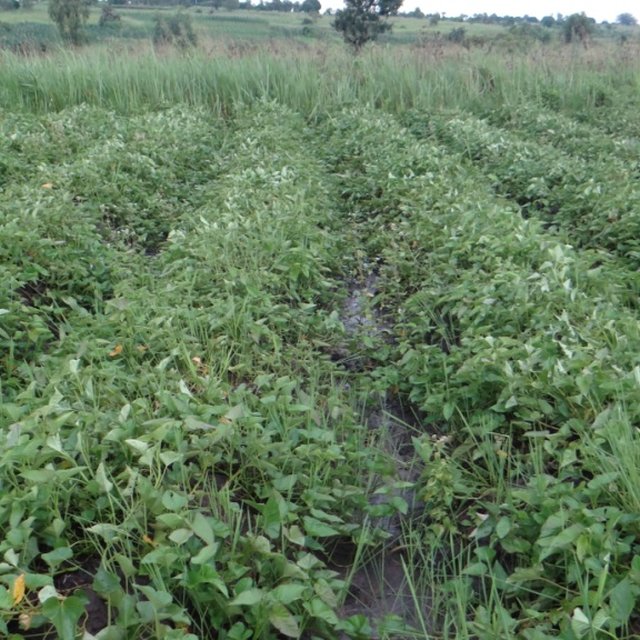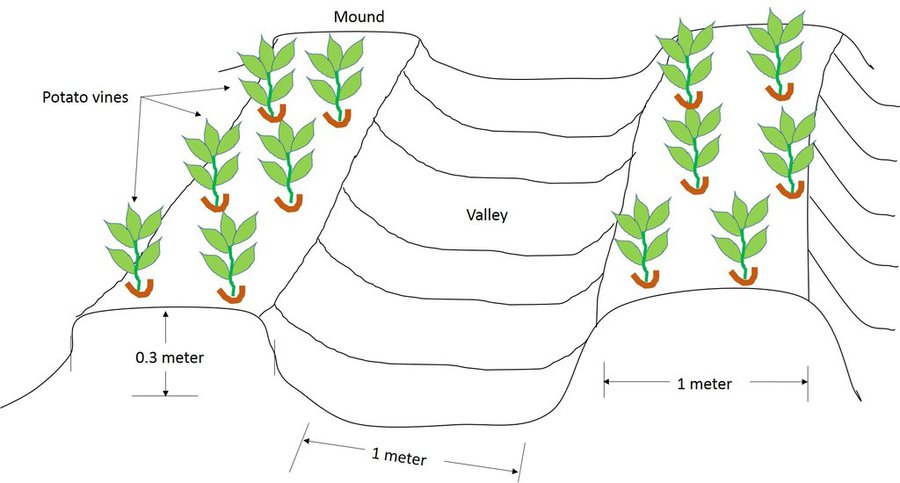



Northern Uganda is mainly semi-arid, receiving rainfall amounts ranging from 600-1000 mm annually. Under these conditions, cultivation of crops is restricted to drought resistant ones such as cassava, sorghum, simsim and ground nuts. Farmers have realized that potatoes are a potential food security crop because they can endure more soil moisture that is available in the lowlands during the dry season. Thus, cultivation of potatoes in wetlands is becoming common because wetlands retain water for longer periods and potatoes, when cultivated, ensure food security during the dry season, a time when other crops are not available, thus bridging the food deficit months.
Sometimes the water in the swamp is more than the potatoes can tolerate. To address this challenge, mounds are made in the garden and the potato vines are planted on the mound rather than in the valley. The size of the mound is approximately one meter wide. The optimum spacing between mounds is also one meter. Potato vines are planted usually at the start of the dry season because this is when the water in the wetlands begins to recede. This is either in June or December. The vines are obtained from neighboring farmers. Weeding is done by manually removing the weeds with either hands or with a hoe. Most of the cultivars in the area are harvested after four months.
The major benefits of this potato growing is to ensure food availability during the dry season when most crops are not available. It also protects the soil as cover-crop, from soil erosion, food security maintaining the tuber for early planting the next season. The major input needed are tuber, labour and land. The benefits of planting potatoes include preventing soil erosion, food and income security. The land user finds the potato crop easy to manage, maturing faster, and being a source of food and income at the same time. Vines from the potato gardens are also used as forage for cows and goats.

Localização: Amuru District, Northern, Uganda
Nº de sites de tecnologia analisados: Local único
Difusão da tecnologia: Uniformemente difundida numa área (approx. < 0,1 km2 (10 ha))
Data da implementação: 2016
Tipo de introdução





| Especifique a entrada | Unidade | Quantidade | Custos por unidade (Uganda Shillings) | Custos totais por entrada (Uganda Shillings) | % dos custos arcados pelos usuários da terra |
| Mão-de-obra | |||||
| Making mounds | Acre | 1,0 | 200000,0 | 200000,0 | 100,0 |
| Weeding | Acre | 1,0 | 50000,0 | 50000,0 | 100,0 |
| Harvesting | Acre | 1,0 | 100000,0 | 100000,0 | 100,0 |
| Material vegetal | |||||
| Vines | Heaps | 20,0 | 10000,0 | 200000,0 | 100,0 |
| Custos totais para a implantação da tecnologia | 550'000.0 | ||||
| Especifique a entrada | Unidade | Quantidade | Custos por unidade (Uganda Shillings) | Custos totais por entrada (Uganda Shillings) | % dos custos arcados pelos usuários da terra |
| Mão-de-obra | |||||
| Planting | Acre | 1,0 | 200000,0 | 200000,0 | 100,0 |
| Weeding | Acre | 1,0 | 100000,0 | 100000,0 | 100,0 |
| Harvesting | Acre | 1,0 | 150000,0 | 150000,0 | 100,0 |
| Material vegetal | |||||
| Vines | Heaps | 20,0 | 10000,0 | 200000,0 | 100,0 |
| Custos totais para a manutenção da tecnologia | 650'000.0 | ||||
The vines are used as fodder after harvest of the potato crop
Potato vines are better quality than many grasses especially during the dry season where pastures are scarce
Making mounds is a labor-intensive activity